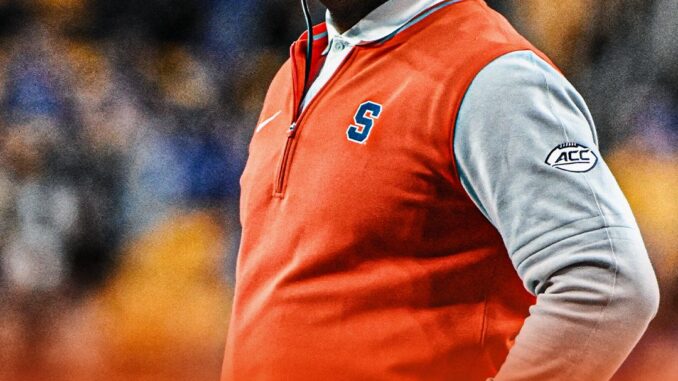
NEW: ACC Fines Syracuse $25,000 for Feigning Injuries Against Clemson
The Atlantic Coast Conference (ACC) has fined Syracuse University $25,000 following its highly scrutinized game against Clemson, citing evidence that players deliberately feigned injuries to slow down the Tigers’ fast-paced offense. The fine, announced this week, underscores the league’s growing frustration with what many view as one of college football’s most controversial tactics—and it sends a clear message that Syracuse crossed the line.
The Incident
The controversy erupted during Syracuse’s recent matchup with Clemson, a game in which the Orange struggled to contain the Tigers’ up-tempo offensive rhythm. Midway through the second quarter and again in the second half, several Syracuse defenders appeared to go down awkwardly after plays, only to return to the field within a few snaps.
Clemson’s coaching staff, along with broadcasters and fans, quickly noted the suspicious timing of these stoppages. Each pause disrupted Clemson’s momentum and gave Syracuse’s defense extra time to regroup. What might have initially appeared as routine injury breaks soon drew accusations of gamesmanship.
The ACC’s postgame review confirmed what many suspected: Syracuse players were instructed, either directly or indirectly, to simulate injuries as a strategy against Clemson’s no-huddle scheme.
ACC’s Statement
In issuing the fine, the ACC emphasized that integrity of play must remain paramount.
“Player safety is of the utmost importance in our conference,” the league’s statement read. “However, deliberately feigning injuries undermines the spirit of competition and compromises the integrity of the game. After reviewing the conduct of Syracuse during its game against Clemson, the conference has determined that disciplinary action is warranted.”
The $25,000 fine is one of the more notable penalties levied for this kind of violation, signaling the ACC’s intention to curb the practice.
Why Feigning Injuries Is Such a Problem
Feigning injuries has become a hot-button issue across college football. Up-tempo offenses like Clemson’s, Oregon’s, or Ole Miss’s thrive on preventing defenses from substituting and forcing them to play tired. For years, defenses have looked for ways to counter this, with “injury timeouts” emerging as a controversial tool.
While no coach will publicly admit to teaching players to fake injuries, accusations have become common. When a defensive player collapses without contact, then jogs off the field smiling or reenters the game moments later, it raises red flags for opponents and officials alike.
The issue also creates a perception problem: true injuries may be met with skepticism, putting player safety and fairness in direct conflict.
Reaction from Syracuse
Syracuse has yet to release a detailed public statement, but sources close to the program suggest the team is frustrated with the penalty. Some within the Orange argue that the fine sets a dangerous precedent, claiming that distinguishing between genuine and feigned injuries is inherently subjective.
Still, the optics from the Clemson game were difficult to ignore. Several instances were captured on national television, with players going down in near unison during Clemson’s biggest surges. Social media erupted with criticism, with fans accusing Syracuse of crossing the line between gamesmanship and outright cheating.
Clemson’s Perspective
Clemson head coach Dabo Swinney, though careful with his words postgame, hinted at his frustrations.
“We play fast, and we’ve seen this before,” Swinney said. “I’ll let the film speak for itself, but I trust the league to handle what they need to handle.”
Clemson fans were less diplomatic, flooding social platforms with clips of the suspicious incidents. For Tiger faithful, the fine validates what they believed all along—that Syracuse attempted to manipulate the rules rather than win outright.
Broader Implications for the ACC
The ACC’s decision to fine Syracuse may prove to be a turning point in how conferences address this growing issue. Until now, leagues have largely been reluctant to levy fines or penalties, preferring to chalk it up as part of the game.
This fine establishes a precedent: teams caught abusing injury stoppages risk financial consequences and public embarrassment. While $25,000 may not cripple Syracuse’s budget, the reputational damage and pressure to clean up tactics will linger.
The league is also expected to revisit its policies at the offseason meetings, with some suggesting harsher penalties—such as loss of timeouts or automatic substitution rules—could be introduced to deter fake injuries in the future.
The Debate Among Coaches and Fans
Not everyone agrees with the ACC’s approach. Some argue that unless there’s definitive proof of acting, the league should tread carefully. Football is a violent sport, and cramps, stingers, and minor tweaks often happen spontaneously. Punishing teams could discourage players from seeking medical attention when they truly need it.
Others counter that the pattern is too blatant to ignore. When multiple defenders collapse only during specific high-tempo sequences and then quickly return to action, the intent becomes clear. For them, the fine is not only justified but overdue.
Looking Ahead
For Syracuse, the fine may serve as a wake-up call. Head coach Dino Babers is under mounting pressure after several disappointing seasons, and controversies like this do little to help the program’s reputation. The Orange must now move forward knowing that the ACC has them under a microscope.
For the ACC, this moment represents an effort to preserve competitive integrity in an era where offensive innovation continues to challenge defensive strategies. The conference’s decision sends a strong message: bending the rules through deception will not be tolerated.
Conclusion
The $25,000 fine against Syracuse marks one of the clearest stands yet against the practice of feigning injuries in college football. While debates about enforcement and fairness will continue, the ACC has drawn a line in the sand.
Feigning injuries may have offered a temporary edge against Clemson’s high-octane attack, but the long-term cost—financially, reputationally, and competitively—could prove far greater.
At its heart, the controversy highlights a central truth: football, at every level, thrives on toughness, resilience, and fairness. When deception replaces those values, the game itself is diminished. The ACC’s ruling makes clear that such tactics won’t go unpunished moving forward.

Leave a Reply